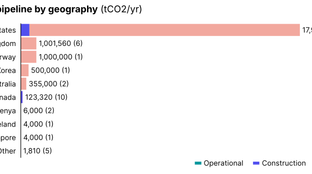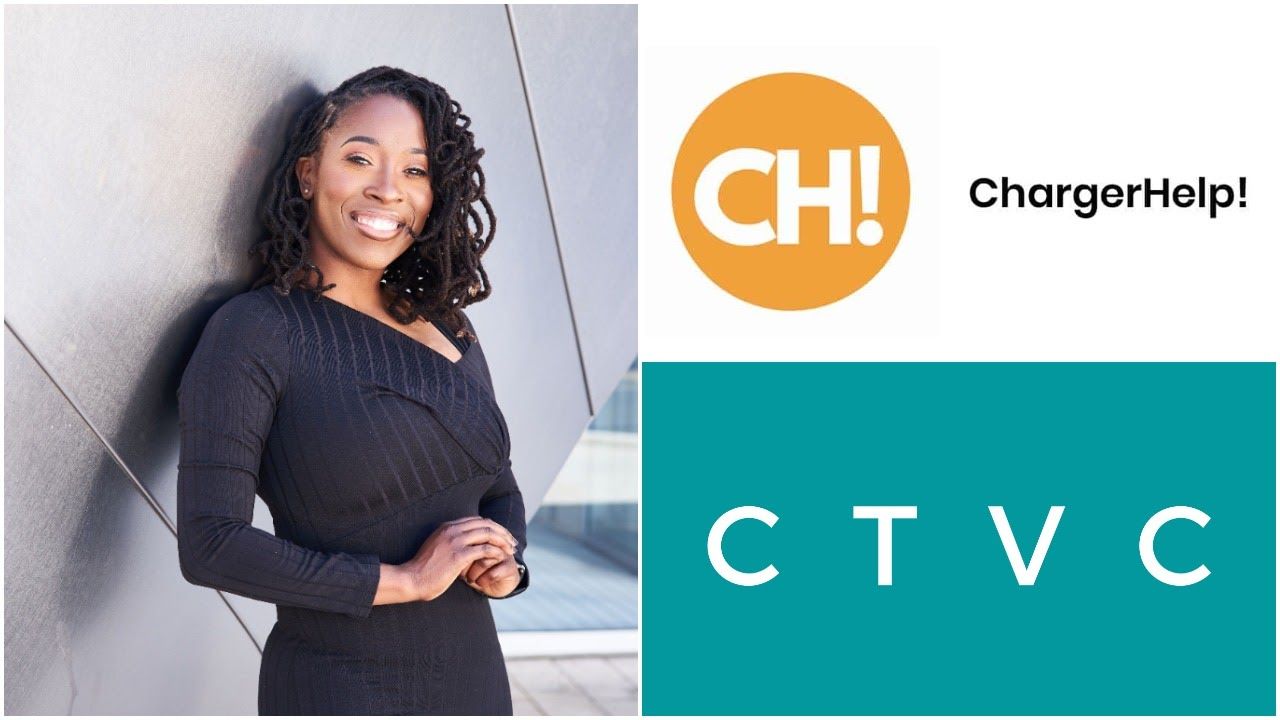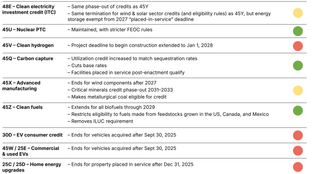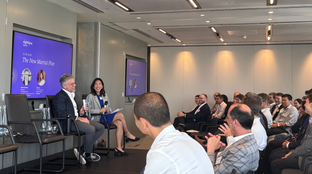
🌎 Taxing times for CCUS #254
OBBB blows tailwinds through CCUS, but takeoff stalls
And Biden’s new $2T (with a T!) Infrastructure Plan
Happy Monday!
It’s not every week that we write on things with a $T in front of them - in one of the most significant climate actions to date, Biden sets the federal government to a 2050 net zero procurement target and denotes $35B for climate science and R&D. We run through the various investments and break down what this means for climate tech.
We also sit down with Kameale Terry of ChargerHelp, who is developing a new vanguard of skilled technicians to power the EV transition. Through targeted local recruitment and workforce development Kameale and her team have made equity a competitive business advantage by plugging communities into the new wave of climate tech innovation.
We also share Netflix’s new sustainability plan, Apple’s energy storage ambitions, and Blackrock’s new sustainability leader.
ICYMI - “Voltswagen’s” flop of an April Fools joke and subsequent lying to the media in the dust of the Dieselgate emissions scandal…
Thanks for reading!
Not a subscriber yet?
On Wednesday, the White House released the American Jobs Plan, a sweeping $2T jobs, infrastructure, and clean energy proposal. Inspiring comparisons to Ike and FDR, Biden’s plan to connect the county is one the most significant climate actions to date and will impact the next decade of climate innovation. The plan could be the start of climate-first policy across a range of government offices and lead to further improvements in public transit, tax changes for legacy polluters rehabbing orphan oil and gas sites.
Unpacking the plan: Biden called it “a once-in-a-generation investment in America, unlike anything we’ve seen or done since we built the interstate highway system and the space race decades ago,” as the NYTimes reports. These are the juicy climate details that jumped out to us:
🛣 $620b for transportation, including $174B for installing a network of 500,000 EV charging stations by 2030, $85B for public transit, electrifying 20% of the school bus fleet, and buying electric USPS vehicles (go ducks!)
🏭 $300b for manufacturing, including $46B for jumpstarting clean energy through federal procurement and achieving net-zero emissions by 2050
⚗️ $280b for job creation and innovation, including $35B for establishing the US as a leader in climate science, innovation, and R&D climate-smart technology
🏛 $286b for buildings, including $40B to retrofit existing public housing to address energy efficiency
⚡️ $266b for utilities, including $100B for improving power grid infrastructure and $66B to updating water system safety and stormwater management
Funding the plan: Three years ago, Trump cut the tax rate to 21% from 35%. Biden proposed a tax strategy to support the plan that would increase the corporate tax rate to 28% from 21%. In the past, infrastructure was paid through user fees. Now, voters support paying with a tax hike.
Selling the plan: Five Cabinet heads – Pete Buttigieg (Transportation Secretary), Jennifer Granholm (DOE), Marcia Fudge (HUD), Marty Walsh (Labor), and Gina Raimondo (Commerce) – will lead the charge in selling the plan to the public and Congress. Pundits argue that Biden could market his plan as a growth strategy to keep up with China – as Eisenhower campaigned the interstate highway system as a national security necessity and FDR promoted the freeways as escape routes for a Soviet attack. For climate tech, China remains the US’ largest competitor and the plan will play well to argue for US climate leadership.
Passing the plan: It’s a long road. While Biden’s plan might be the only climate-focused proposal to come from a president, it’s massive size poses a conundrum. Biden’s $2T plan makes Obama’s $90B clean energy investment (proposed in the 2009 stimulus) look puny, but, as Farhad Manjoo writes, “Any plan bold enough to effectively address climate change seems unlikely to survive the American political system. And any bill that can survive our politics may not make enough of a dent on the climate.”
🌱 LiveKindly Collective, a Los Angeles, CA-based portfolio of plant-based food brands, raised $335m from TPG Rise Fund, Rabobank and S2G Ventures.
⛅ Tomorrow.io, a Boston, MA-based weather intelligence platform, raised $77m in Series D funding from Stone Court Capital and Highline Capital.
🍄 Ecovative, a Green Island, N.Y.-based mycelium technology company, raised $60m in Series D funding from Viking Global Investors, Senator Investment Group, AiiM Partners, and Trousdale Ventures.
✈️ ZeroAvia, a hydrogen-powered aviation startup, raised $24.3m in new funding from Horizons Ventures, Breakthrough Energy Ventures, British Airways and Shell.
⚡ ChargerHelp, an Los Angeles, CA-based on-demand repair app for electric vehicle charging stations, raised $2.75m in Seed funding from Trucks VC, Kapor Capital, JFF, Energy Impact Partners and The Fund.
Lilium, a Germany-based air taxi developer, is going public via SPAC Qell Acquisition Corp., valuing the company at $3.3b.
Vision Ridge Partners raised $1.25b for its third sustainable asset fund.
Energize Ventures and Caisse de dépot et placement du Québec announced a $125m co-investment partnership in clean energy technologies.

This week we sat down with Kameale Terry, the CEO of ChargerHelp, to learn about their industry-leading workforce development program for recruiting and training EV charging technicians. ChargerHelp closed a fresh $2.75m Seed investment this week from Trucks VC, Energy Impact Partners, Kapor Capital, JFF, and The Fund. [We’ve edited the newsletter version for length; visit our website for the full feature]
Let’s start from the beginning. What’s the story behind ChargerHelp?
I started as a banker in Philadelphia, but had to move back to Los Angeles due to my mom’s health conditions. To fit my schedule, I started working at an EVSE network provider as a driver support agent and ended up managing all of our US charging stations. As we grew, I had the opportunity to stand up that company's customer experience department and network operations center.
Then as the Director of Programs supporting our infrastructure buildout, I began to notice the recurring challenge of maintaining charging stations’ uptime. We relied heavily on electrical contractors for repairs, but 80% of the charger issues weren’t electrical - they were software or firmware issues, or vandalism. This was especially a big deal in California, where cap and trade credits are based upon usage, and an abandoned charger station is a massive loss in revenue.
Charger downtime wasn’t just a pain point for that company - it was an industry-wide issue. Utilities reported 30% of their charging stations were offline due to maintenance issues. Our industry didn’t have a specialized workforce that could fix hardware and software issues of nationally deployed ev charging stations. We started ChargerHelp to facilitate the hiring of trained technicians and to develop a specialized workforce to fix EV charging stations.
Amazing. What’s the scale of this maintenance pain point for the EV charging networks?
At gasoline stations an attendant reports and manages any fueling issues. EV charging decentralizes the fueling process and doesn’t require attendants, but as a result there’s more vandalism and downtime from broken infrastructure. With mass adoption of EVs on the horizon, your average future EV driver will be less forgiving than the eager initial adopters who put up with the various bumps and hurdles of early generations of EVs. As the Biden-Harris administration commits more federal dollars to EV adoption, these stranded charging assets will no longer be acceptable. Therefore, we want to be the support system for our entire industry.
At ChargerHelp, our solution is two-fold: first, our technician workforce acts as the “attendant” for charging stations, and second, our data will ease the challenges from a heterogeneous EV charging industry. Because we serve so many different charging network providers and manufacturers, there is no standard troubleshooting guidance across all this varied software and hardware.
What is your long-term vision for ChargerHelp to become the platform for EV charging maintenance?
Right now, we’re focused on getting technicians on the ground. Our long-term vision is to be a data-driven diagnostics engine. For example, we’ll be able to go back to the customer and help them to determine that the cause of their recurring error is a faulty part, and then make recommendations to replace that supplier to prevent future issues. Today, most charging networks have no way to track their maintenance and repair needs or costs since they use so many different electricians. ChargerHelp provides a repeatable service and can aggregate repair data to provide better transparency into areas for improvement.
How do you approach hiring for your cohorts and general workforce development?
We start by looking for geographic areas with a concentration of at least 200 stations. We then partner with the local workforce development center that facilitates our recruiting process in that local community. Our last recruitment saw a little over 1,600 people apply for the 20 open positions. I think this number is a sign of the times and also a reflection of the quality of job we’ve brought to the market. We hope to be an example for other technology companies.
I must give a nod to my co-founder who worked for the Department of Labor for 10 years helping major car OEMs with mass hiring - she has put a tremendous amount of thought into our recruiting process. For our first tranche of technicians, we recruited from talent pools in oil and gas, telecom and communications, as well as from electrical contractor apprenticeship programs.
We believe the workforce of the future will optimize for people with high emotional intelligence. EQ shows up in soft skills, not in what school you went to or what certifications you have. Our recruiting process for an individual is about 1.5 months long. We hold group problem solving interviews in which we observe dynamics between candidates like who’s overtalking, asking questions, being polite, etc. We hire in cohorts because we value the continuous learning between technicians. I hope that sharing more about our recruiting model helps other startups think outside of the box about their own hiring processes.
What benefits do you offer ChargerHelp technicians?
Our employees earn $30/hour minimum, full-time benefits, and are compensated throughout two electrical contractor certifications. ChargerHelp employees also get shares in our company - they’re treated as an integral part of the company, since it’s their work that generates our profit margin after all.
At ChargerHelp, we ensure that our technicians earn a middle class income so they can afford an EV and have the buying power to be a part of the green economy that they’re helping to repair.
ChargerHelp has done phenomenal work providing a working example of how to create an equitable and just green transition. How do you think that the massive tailwinds from Biden’s $2t infrastructure plan will expedite this just green transition?
A lot of people have asked me about this. Honestly, I get worried about all of this new emphasis on our industry, especially around generating green jobs. Sometimes throwing a lot of money at a problem too quickly has adverse consequences. My fear is that too much money too quickly will cause everything that we’ve been touting about equity to disappear. We must ensure that this influx of money and interest is directed at the right folks.
I’ve been pushing and asking for my team to be in the room where these decisions are made. Figuring this stuff out isn’t easy, you need to be very strategic. Look, it’d be much easier and faster for ChargerHelp to go out and hire non-community based technicians, but there are long-term profit-driven reasons that we go through a month and a half’s worth of recruiting.
You just raised a $2.75m Seed round from Trucks VC, Kapor Capital, Energy Impact Partners, JFF, and other powerhouse climate investors. How was the fundraising process? And what’s next?
We started fundraising in February 2020, right before the pandemic and before the world realized that we should stop killing Black people. So, in my mind, I felt like there were some microaggressions - like investors only talking to us because we were two Black female founders, and they needed to check the diversity box off their list. We lost time in a lot of conversations where it became clear that they were never interested in actually writing a check, yet put us through more due diligence than was typical of a company at our stage.
We finally found the right group of investors. Trucks VC focuses on expanding the future of mobility, Kapor and JFF focus on workforce development impact, and EIP is backed by the utilities that run the charging industry.
Now that we’ve finally completed the raise, we’re laser focused on delivering on our customer contracts. With this capital we’ll also start building and growing, but we have to be strategic and ensure that we’re taking care of our people and maintaining our company culture. The work that we’re doing is not charity. Our recruiting and workforce development approach is the best way to build a business; we hire for potential as an EV charging technician, not by relying on signals from degrees.
Want to plug in to the ChargerHelp movement? Keep an eye on the company careers page for a soon to be released role for Director of Operations. Do you know how to get Kameale and ChargerHelp in “the room where it happens” to contribute to the conversations around green workforce development in the Biden administration? Reach out.
[Disclaimer: Kim is an investor at Energy Impact Partners]
The White House is blowing tailwinds behind the US offshore wind industry and aims to build 30GWs of offshore wind capacity by 2030, with Long Island and New Jersey prioritized as the first to see turbines off their shores. No doubt our friend, Jigar Shah, at the DOE loan’s program office will seize the opportunity to fund a combo of wind and much needed transmission.
The Biden administration is sowing the seeds for a multibillion-dollar carbon bank to pay farmers for soil carbon sequestration.
Rounding out a week of strong environmental policy, the Biden administration formed the White House Environmental Justice Advisory Council to develop broad strategies in combatting environmental injustice – overshadowing the role played by the EPA for two decades.
Netflix announced their plans to achieve net-zero by the end of 2022 (less than 2 years?!) through their three core strategies: Reduce, Retain, and Remove carbon dioxide.
Apple is set to collaborate with Tesla to bring Megapacks to their existing solar farms to power their operations and supply chains. Moving one step further down the supply chain, Apple also announced its 110 suppliers will also decarbonize their own electricity consumption.
SP Blackrock hires Paul Bodnar, the former Chief Strategy Officer at the Rocky Mountain Institute as the head of sustainable investing at Blackrock.
BCG released a survey report - The Next Generation of Climate Innovation - sharing their thoughts on how new markets and new business frameworks can spur new technologies that will help achieve the last mile of decarbonization
Google Maps will soon offer a “lowest emissions” route based on traffic, slopes, and other factors.
The pandemic ground ridership and revenue to a standstill, but public transit offers a simple way for cities to lower GHG emissions.
Imperial and the IEA find that clean energy investors tripled the returns of fossil fuel investors over the past decade in a new report.
Are we winning, sun? A new report from the National Academies of Sciences, Engineering, and Medicine suggests that we may need to start seriously considering and researching solar geoengineering.
More than 10m acres of tropical forest (roughly the size of Switzerland!) was lost in 2020, up 12% from the year before.
Speaking of deforestation, the “blob” and “zombie” urchins now haunt our forests. Kelp forests, to be exact.
🗓️ 2021 MIT ClimateTech and Energy Prize Semifinals: Tune in on April 8th for the semifinals of the longest running and largest climate tech startup competition for university students.
Sustainability Business Strategy Leader @Microsoft
Cleantech Account Supervisor @Antenna
Global Data Centers Sustainability Lead @Google
Associate Director, Programs Operation @Climateworks Foundation
Fellow @Fifty Years
Investment Director @CREO Syndicate
Analyst @Cantos Ventures
Associate @Urban Innovation Fund
Carbon Removal Hardware Lead @Heirloom
Feel free to send us new ideas, recent fundings, or general curiosities. Have a great week ahead!

OBBB blows tailwinds through CCUS, but takeoff stalls

One Big Beautiful Bill ushers in new (and old) energy agenda

Climate, capital, and carrots in London's new playbook